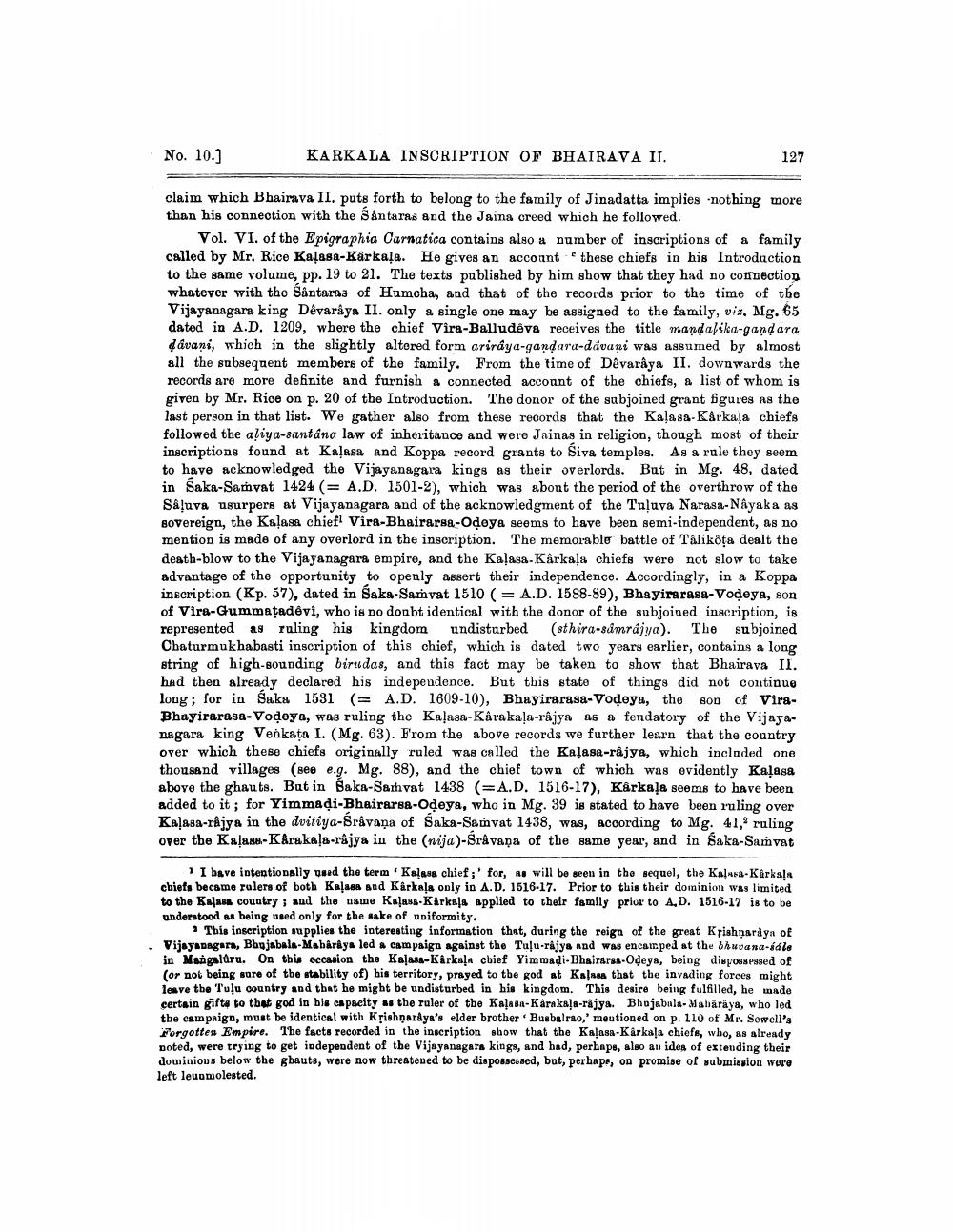________________
No. 10.]
claim which Bhairava II. puts forth to belong to the family of Jinadatta implies nothing more than his connection with the Sântaras and the Jaina creed which he followed.
KARKALA INSCRIPTION OF BHAIRAVA II.
127
Vol. VI. of the Epigraphia Carnatica contains also a number of inscriptions of a family called by Mr. Rice Kalasa-Karkala. He gives an account these chiefs in his Introduction to the same volume, pp. 19 to 21. The texts published by him show that they had no connection whatever with the Sântaras of Humcha, and that of the records prior to the time of the Vijayanagara king Dêvaraya II. only a single one may be assigned to the family, viz. Mg. 65 dated in A.D. 1209, where the chief Vira-Balludeva receives the title mandalika-gandara dávani, which in the slightly altered form ariraya-gandara-dávani was assumed by almost all the subsequent members of the family. From the time of Dêvaraya II. downwards the records are more definite and furnish a connected account of the chiefs, a list of whom is given by Mr. Rice on p. 20 of the Introduction. The donor of the subjoined grant figures as the last person in that list. We gather also from these records that the Kalasa-Karkala chiefs followed the aliya-santano law of inheritance and were Jainas in religion, though most of their inscriptions found at Kalasa and Koppa record grants to Siva temples. As a rule they seem to have acknowledged the Vijayanagara kings as their overlords. But in Mg. 48, dated in Saka-Samvat 1424 (= A.D. 1501-2), which was about the period of the overthrow of the Saluva usurpers at Vijayanagara and of the acknowledgment of the Tuluva Narasa-Nayaka as sovereign, the Kalasa chiefl Vira-Bhairarsa-Oḍeya seems to have been semi-independent, as no mention is made of any overlord in the inscription. The memorable battle of Tálikôța dealt the death-blow to the Vijayanagara empire, and the Kalasa-Karkala chiefs were not slow to take advantage of the opportunity to openly assert their independence. Accordingly, in a Koppa inscription (Kp. 57), dated in Saka-Samvat 1510 (= A.D. 1588-89), Bhayirarasa-Voḍeya, son of Vira-Gummaṭadevi, who is no doubt identical with the donor of the subjoined inscription, is represented as ruling his kingdom undisturbed (sthira-samrajya). The subjoined Chaturmukhabasti inscription of this chief, which is dated two years earlier, contains a long string of high-sounding birudas, and this fact may be taken to show that Bhairava II. had then already declared his independence. But this state of things did not continue long; for in Saka 1531 (= A.D. 1609-10), Bhayirarasa-Voḍeya, the son of ViraBhayirarasa-Vodeya, was ruling the Kalasa-Kârakala-rajya as a fendatory of the Vijayanagara king Venkata I. (Mg. 63). From the above records we further learn that the country over which these chiefs originally ruled was called the Kalasa-rajya, which included one thousand villages (see e.g. Mg. 88), and the chief town of which was evidently Kalasa above the ghauts. But in Baka-Samvat 1438 (A.D. 1516-17), Karkala seems to have been. added to it; for Yimmaḍi-Bhairarsa-Oḍeya, who in Mg. 39 is stated to have been ruling over Kalasa-rajya in the dvitiya-Sravana of Saka-Samvat 1438, was, according to Mg. 41, ruling over the Kalasa-Karakala-rajya in the (nija)-Sravana of the same year, and in Saka-Samvat
1 I bave intentionally used the term 'Kalasa chief; for, as will be seen in the sequel, the Kalasa-Karkala chiefs became rulers of both Kalasa and Karkala only in A.D. 1516-17. Prior to this their dominion was limited to the Kalasa country; and the name Kalasa-Karkala applied to their family prior to A.D. 1516-17 is to be understood as being used only for the sake of uniformity.
This inscription supplies the interesting information that, during the reign of the great Krishnaraya of Vijayanagara, Bhujabala-Maharaya led a campaign against the Tulu-rajya and was encamped at the bhuvana-idle in Mangaluru. On this occasion the Kalasa-Karkala chief Yimmadi-Bhairarsa-Odeya, being dispossessed of (or not being sure of the stability of) his territory, prayed to the god at Kalasa that the invading forces might leave the Tulu country and that he might be undisturbed in his kingdom. This desire being fulfilled, he made certain gifts to that god in his capacity as the ruler of the Kalasa-Karakala-rajya. Bhujabala-Maharaya, who led the campaign, must be identical with Krishnaraya's elder brother Busbalrao,' mentioned on p. 110 of Mr. Sewell's Forgotten Empire. The facts recorded in the inscription show that the Kalasa-Karkala chiefs, who, as already noted, were trying to get independent of the Vijayanagara kings, and had, perhaps, also an ides of extending their dominious below the ghauts, were now threatened to be dispossessed, but, perhaps, on promise of submission were left leunmolested.




